|
|
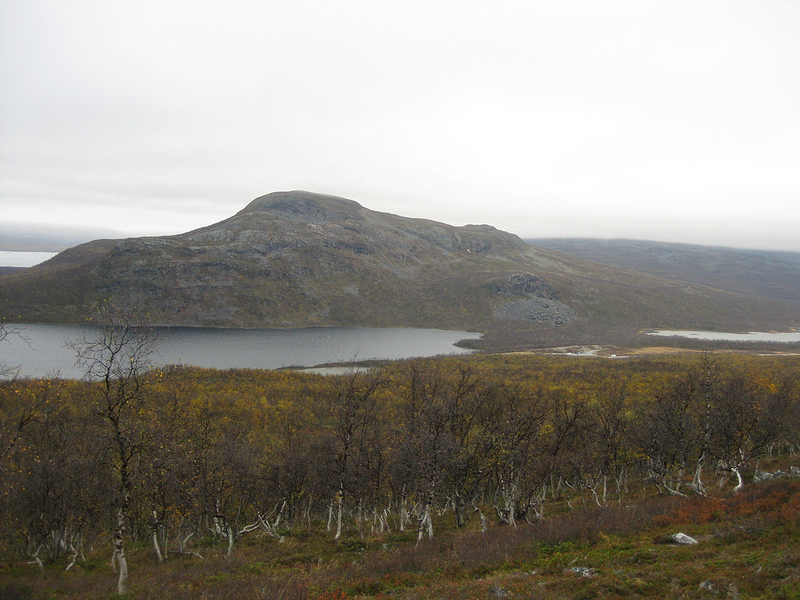 dwarf birches and tundra 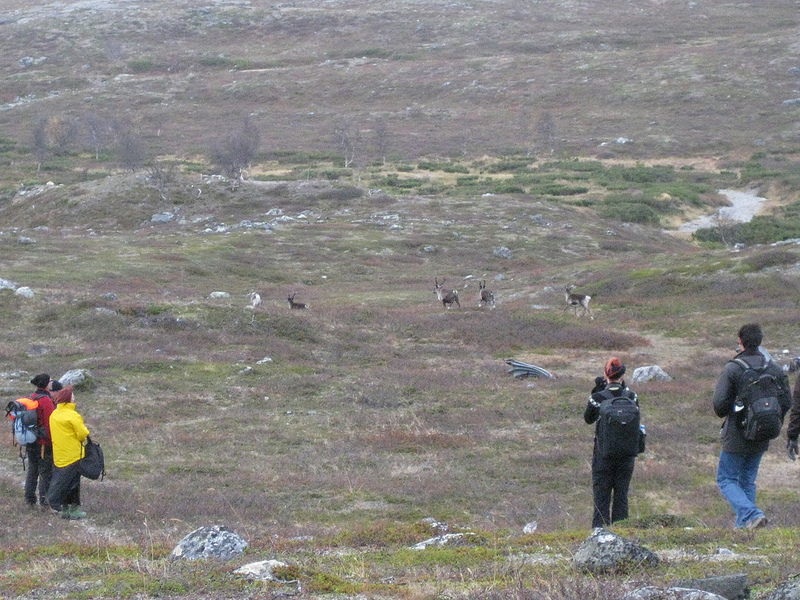 suddenly – reindeer!
The morning broke grey and brooding outside the Kilpisjärvi Biological Station and after a quick breakfast, we were on the trail, hiking up Saana Fjell, guided by Erich Berger of the Finnish Bioart Society. The idea was to familiarize ourselves with the geology, ecology and cultural history of the vicinity so we could dive into our research plans as soon as possible.
The Australian bio-hacker, Oron Catts had already been here for a week to do some scouting for his group’s ‘Journey to the Post-Anthropogenic’ project. They planned to perform a comprehensive bio-archeological survey of the crash site of a German Junkers 88 bomber that came down on Saana in 1942, which included a metagenomic analysis of the plane’s debris field and a recreation of the crash trajectory using a remote-controlled drone.
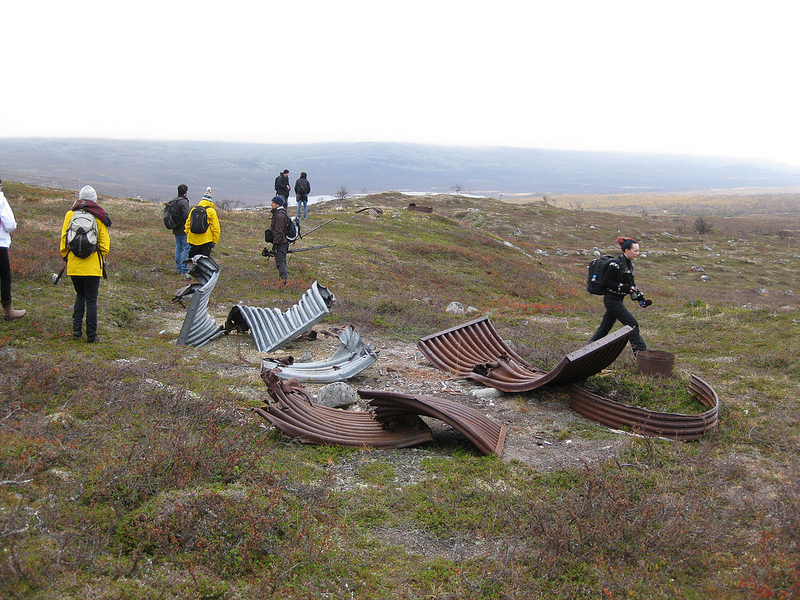 debris field It wasn’t long before we passed the tree line where the mountain birches gave way to an expanse of open tundra sweeping out before us in a swath of russet heath and exposed rock, with quivering patches of silver cloud here and there snagged on the crenellations of the topography. As if on cue, a small herd of reindeer appeared over the crest of a nearby hill and galloped across our field of view, cocking their heads as they past us and then just as quickly melting into the gloom of the opposite horizon. It is hard to judge distances here in this cold desert. An unusual rock formation in the distance might be small and quite close by or enormous and very far away.
I felt for a moment as if I had been transported back to the Pleistocene, as the landscape I was looking at was what much of Europe and North America would have been like at the end of the last Ice Age, though (other than the reindeer) there wasn’t any of the charismatic megafauna such as the woolly mammoth and the cave lions I would have had to concern myself with back then. Semi-domesticated, reindeer have sustained the local Sami people since ancient times and they are of the few creatures (other than snails) to manufacture the enzyme lichenase, enabling them to survive on lichen during the winter months.
How this delicate ecological balance will be affected by climate change is unclear but to my mind it doesn’t look good. Lichens exist in fairly specific temperature and humidity conditions and in Kilpisjärvi many are symbiotic with the birch trees, themselves a cold-dependent species. A continued warming trend in this region is bound to mean diminishment of suitable reindeer habitat. This has already occurred in North America, where the closely related Woodland Caribou has steadily disappeared from the southern portions of its range.
Standing in the middle of this iconic subarctic landscape, it is hard to imagine rapid changes occurring. For thousands of years, the processes shaping it have been gradual and incremental – the slow scouring of glaciers advancing and retreating, the infiltration of frost with its insidious heaving and splitting, the seasonal flows of meltwater into the lakes and rivers. The cold accentuates the sense of Deep Time here. Rocks dragged by ancient ice flows sit solemnly in place as if they stopped moving only yesterday. The sparse, slow growing vegetation is no match for the overwhelmingly geologic feeling of the place. Even minor disturbances stay visible for centuries.
But add even a small degree of warming and there would be potentially huge changes. Vegetative growth would ramp up, allowing trees to flourish in areas that were once windswept barrens. It is easy to imagine the slopes of Saana darkening as the Scotch Pine (Pinus sylvestris), now found only intermittently in the Kilpisjärvi area but quite common further south, finds conditions more suitable to it and becomes a dominant species. True tundra and the flora and fauna that depend on it could disappear from the area entirely.
 lone Scots pine Fast-forward a little further and there could be a whole host of new species that find the once frigid environs of Kilpisjärvi newly tolerable. A good many of these are likely to be weeds, which thrive on man-made disturbance. Investigating the grounds around the research station, I soon found a small clump of English plantain (Plantago major) a cosmopolitan weed, dubbed the ‘white man’s footprint’ by North American First Nations, who noticed it growing wherever European colonizers had disturbed the original ecosystem. The humble plantain is just the beginning. I predict that larger weed species will soon be gaining a foothold at Kilpisjärvi; their seeds imported on tire treads or blown in with the wind.
I wondered how it might look here when Ailanthus altissima, a tree variously known as the ‘Ghetto Palm’ or ‘Tree of Heaven,’ moves into the Finnish subarctic. Originally from China, Ailanthus is exuberantly invasive, and has already moved into ruderal (ruin) ecologies throughout the world without any signs of stopping. This tree has the astounding ability to feed off concrete, allowing it to thrive in cracks in pavement, the roofs and facades of under-maintained buildings and pretty much any other place its myriad seeds are able to lodge themselves long enough to germinate.
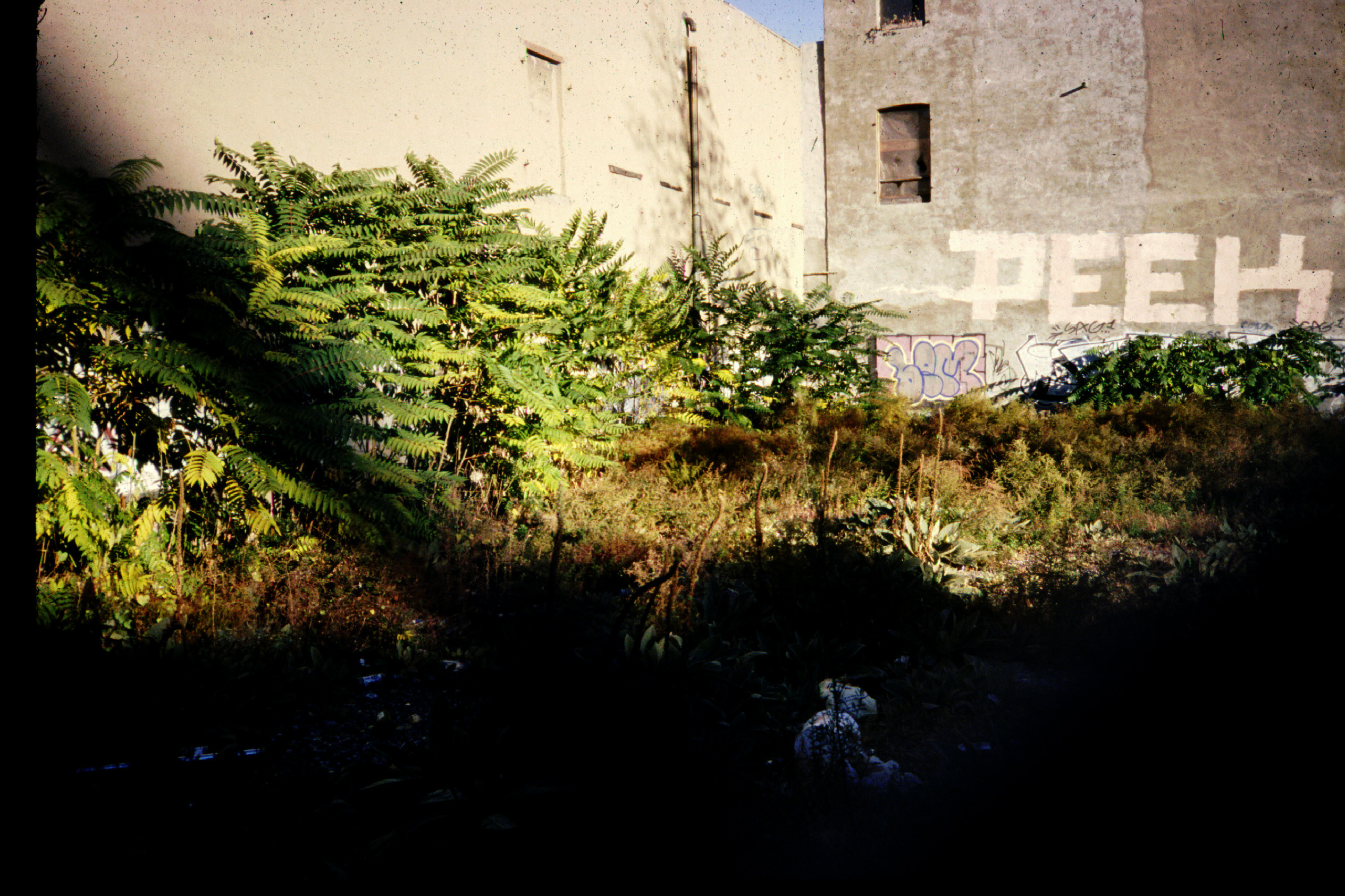 Ailanthus trees As the global south becomes uninhabitable due to increasing drought, wildfire and relentless heat, it isn’t hard to imagine a newly temperate Kilpisjärvi becoming a major magnet for climate refugees, human and non-human. Higher annual temperatures, as well as attracting different flora and fauna, could make the cultivation of cereal crops a possibility and perhaps other kinds of intensive agriculture, now more characteristic of Central Europe. This could transform the wild, transhumance landscape into a ‘Kulturlandschaft,’ the subarctic wilderness giving way to ploughed fields, perhaps even orchards. There might be a property boom as the open range lands once suitable only for reindeer husbandry become hosts to cash crops and housing estates. The effect on the traditional Sami lifestyle would be incalculable.
A climate-changed Kilpisjärvi would be a kind of ‘hyperecology’– a co-mingling of adaptive, cosmopolitan weeds, perhaps a few resilient local organisms and a steady in-migration of biota from the south. Outside the national parks and reserves, post-climate change nature will have even less of a free hand. There is massive industrial development afoot for Lapland, particularly mining and its ancillary industries which threaten to blight vast tracts of the relatively pristine landscape with open pit mines, tailings ponds and processing infrastructure, which, as well as inevitably introducing all sorts of pollution will create a new terrain vague of slag heaps and factory wastelands. These ‘brownfields,’ ubiquitous in much of the industrialized world are the preferred habitats of the globally distributed ragamuffin flora: Ailanthus, Buddlea and Robinia, which find the toxic and impoverished soils to their liking.
Industrialized, intensely cultivated and densely populated, the Kilpisjärvi of the not-to-distant future might look strangely familiar to any present day resident of a more temperate latitude. Yet what has been predictable there for so long will soon become much more extreme. We may all find ourselves moving north.
But climate change isn’t likely to stop at this arbitrary point. The heat will likely continue to build, especially if mankind continues dumping carbon into the atmosphere and particularly if the much feared ‘runaway greenhouse’ effect kicks in. What then for Kilpisjärvi? The Paleocene-Eocene Thermal Maximum that happened some 55 million years ago gives us a clue. In those days, the weather north of the Arctic circle was sultry and humid the year round. In addition to the Sciadopitys trees I described in my previous posting, vast swamp forests of Metasequoia and Taxodium spread out across the far north of Eurasia and North America, with turtles and crocodiles plying through the black water and mire. It would have resembled the bayou country of Louisiana or subtropical China, with snow and ice pretty much non-existent, a far cry from the frigid Kilpisjärvi of today, which can be icebound 200 days a year.
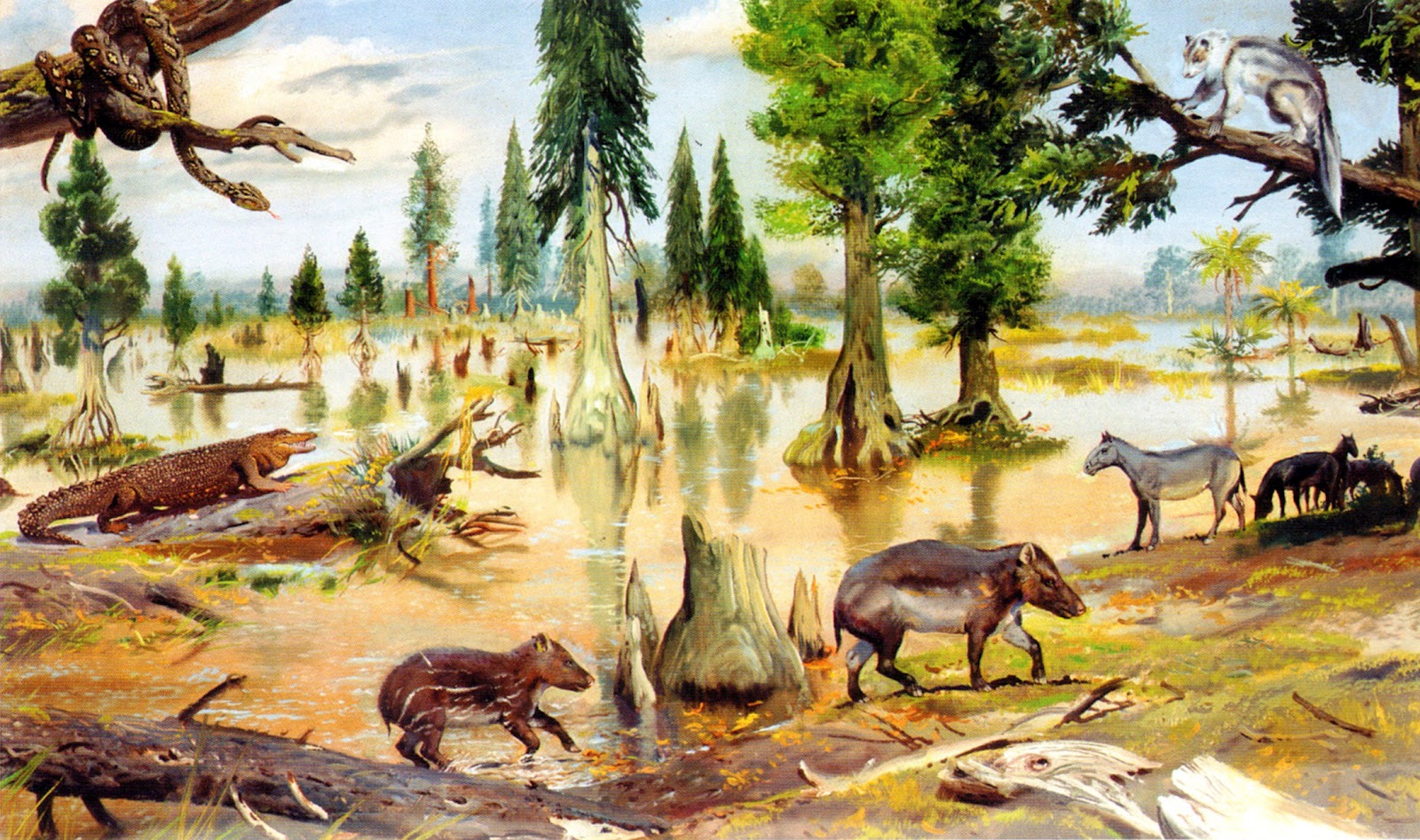 Eocene landscape Northern regions are well on track for a repeat of these subtropical conditions according to the most agreed upon climate change models, which predict an up to 4 degree Celsius rise globally by the end of the century, with a strong likelihood that changes in high latitudes will be more extreme. Though the biota will surely be more impoverished than it was in the Eocene, not having had anywhere near as much time to evolve, an anthropogenically tropical Lapland would be a mind-boggling yet disturbingly real possibility.
Though our species’ effect on climate can (and will) precipitate far-reaching changes in areas like Kilpisjärvi, there are many planetary processes playing out over which we have no control. The evolution of biota over Deep Time is as much happenstance as forward movement, with periods of great flourishing such as the infamous ‘Cambrian Explosion’ interspersed with ‘reversal’ or mass extinction, either organically or extraterrestrially engendered, which often obliterate whole classes of once dominant organisms and provide opportunities for minor ones to come out of the wings.
Past instigators of mass extinction have included: asteroid impacts, widespread volcanic eruptions with concomitant ocean acidification, even the evolution of photosynthesis by cyanobacteria, which released the toxic gas oxygen into the atmosphere to the detriment of the once dominant anaerobes. Any and all of these scenarios will likely play out again somewhere in the fullness of Deep Time, but barring the elimination of all life on the planet, it is worth speculating on the impact such upheavals would have on the vegetated landscape.
For example, what would happen if flowering plants, also known as angiosperms, dramatically declined, perhaps taken out by some pandemic or selective evolutionary pressure? They’ve really only been common since the Cretaceous and it isn’t hard to imagine Kilpisjärvi’s abundant so-called ‘lower’ plants – mosses, club mosses and liverworts, moving into the vacuum and attaining gigantic proportions, as was the case during in the coal swamps of the Carboniferous Period.
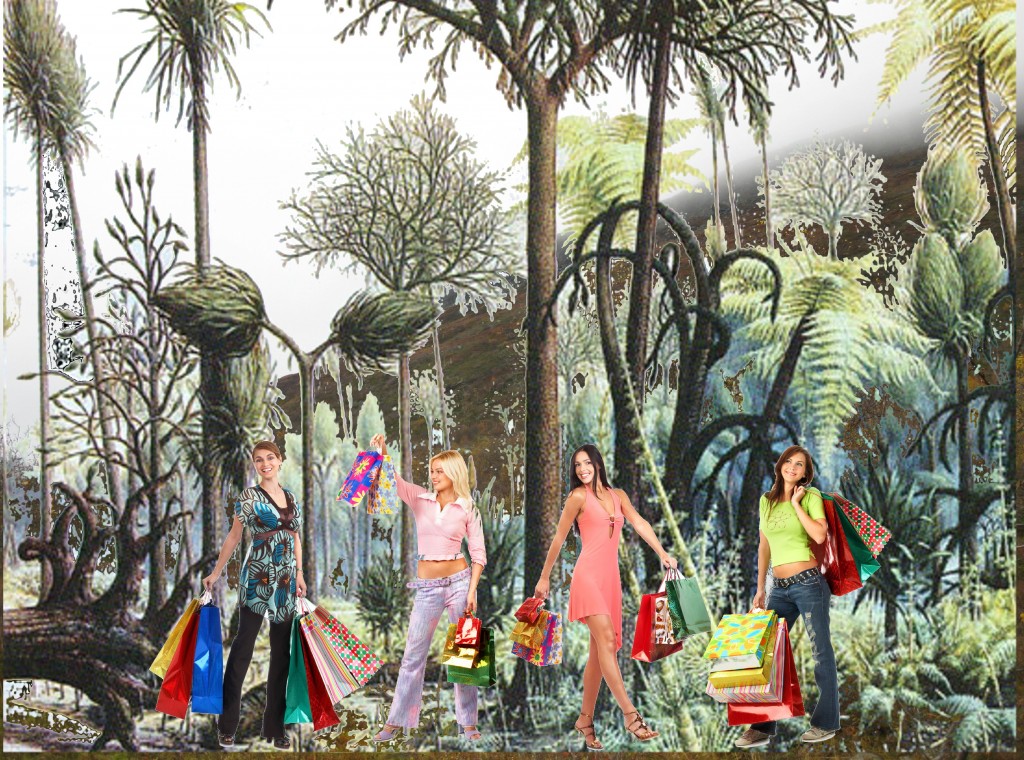 Neo-Kilpisjärvi with giant club mosses A reduction in the availability of sunlight due to volcanic ash or widespread dust storms could have equally bizarre consequences. With green plants and algea in decline because of the challenge to photosynthesis, there would be a selective advantage for fungi, which might take over Kilpisjärvi forming bizarre, colossal structures as they did during the Devonian Period, some 400 million years ago, and again during the mayhem of the Permian mass extinction. Whether our own species would survive under such extreme and alien conditions is an open question, but life of some sort is almost certain to find a way. Perhaps fungi will regroup to form the planet’s supreme intelligence. Some would say, they already have!
It is this last point that gives me a vestige of hope. We Homo sapiens are a problematic creature, a classic, invasive species that thrives on disturbance, tends toward monoculture and displaces competing biota from its habitat. Yet in the overall scheme of things we are likely to be a transient phenomenon. We will either precipitate our own extinction, (and if the surviving ecosystems of the planet could sigh in relief, they surely would!), or we will find a way to live within our ecological means and develop a more equitable arrangement with the fellow denizens of the biosphere. My stay at the Kilpisjärvi Biological Station offered me the ideal vantage point to consider this conundrum. What we are in now is not so much of a ‘watershed’ moment but more of a ‘timeshed’ moment!
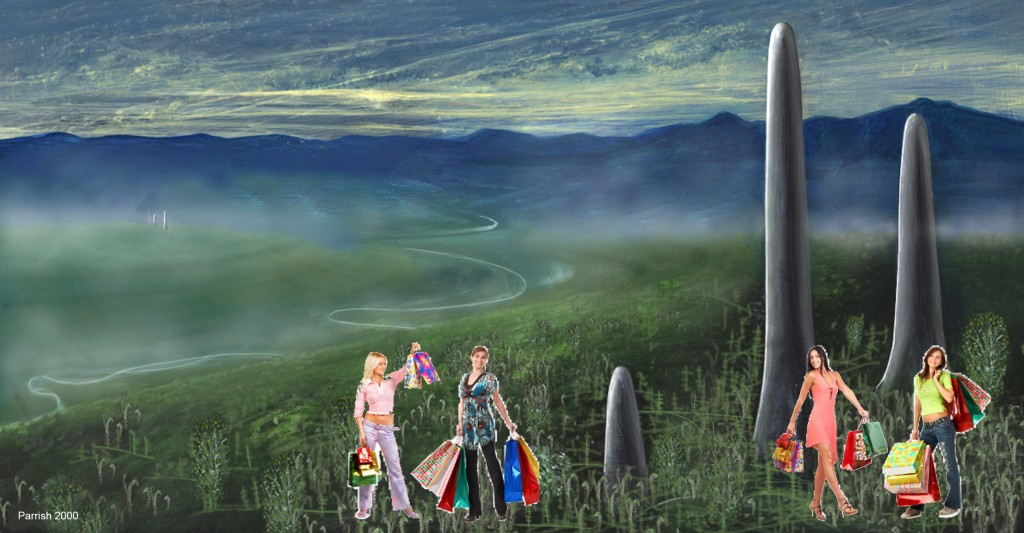 Neo-Kilpisjärvi with giant fungi
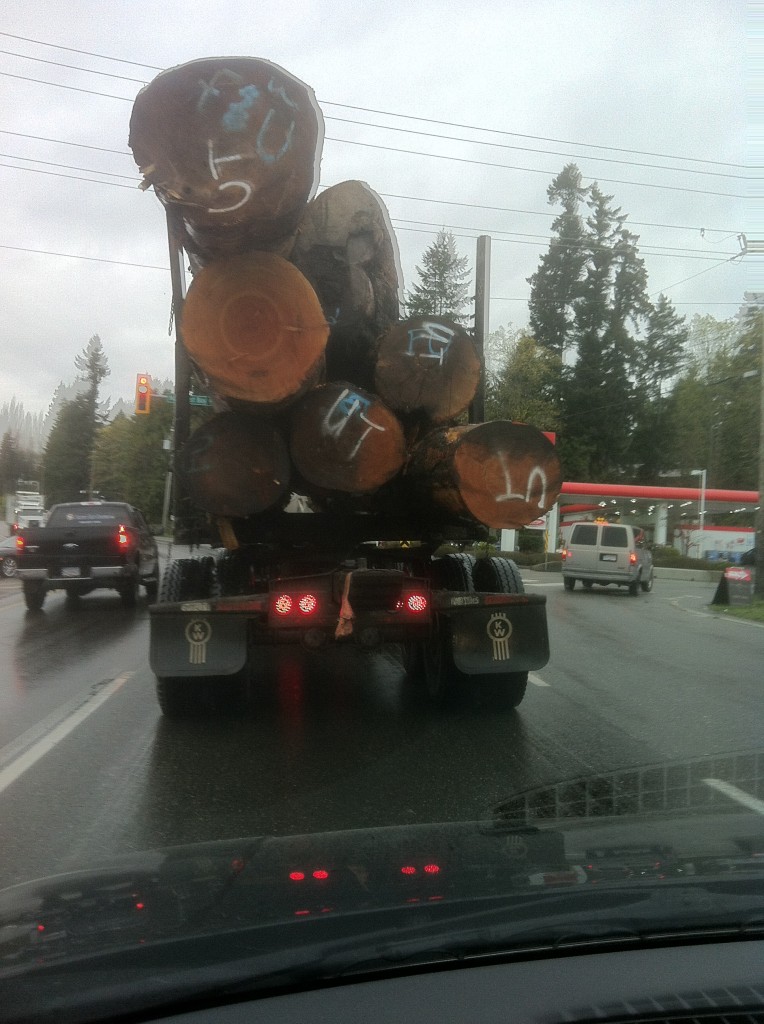 Vancouver Island highway scene At this ardently bright juncture of the year, there is something quite delightful about gazing up into the cool, rustling canopy of overhanging trees. It is a very deep memory for me. I must have been an infant, lying on the back bench seat of my parents’ old Buick, gazing up through the rear window at the dark tunnel of foliage billowing overhead, flashing here and there with orange bursts of interpenetrating sunlight. The dust from the road was starting to smell like the softer evening version of itself and the roadside insects, cicadas probably, hissed in their enormous, invisible numbers.
In my recent journeys between England and Canada, I have been struck by the contrast in attitudes toward what one might call ‘arboreal heritage’ between the two places. When driving on Vancouver Island I am inevitably torn between throwing up and crying whenever I see, as I almost always do, some of the last old growth Douglas firs (Pseudotsuga menziesii) getting hauled down the highway on some logging truck. Their rate of felling has been accelerated recently by a growth in demand from overseas, particularly Chinese, markets and the provincial government’s stupendously short-sighted decision to relax restrictions on the exporting of raw logs.
Each one of these ancient trees is a monument to the passing of centuries, a lynchpin around which complex ecological processes have evolved and yet we are losing the last primeval stands right at this very moment. To see one of those loaded trucks is like witnessing the carcass of a blue whale or a rhinoceros trucked off to a dog food factory but what more is there to be said? We have pointed our fingers yet the market economy has triumphed and the trees continue to fall. Soon all there will be left is a lingering sense of shame until that too eventually disappears. Outside a few relic specimens that happen to find themselves inside parks, the ancient fir groves of Vancouver Island will soon be obliterated. The Island Timberlands company continues to be a key player in this campaign of ecological extermination and is specifically targeting the large old trees on its vast private holdings to service an international market growing all the more lucrative as the global supply of first growth trees plummets.
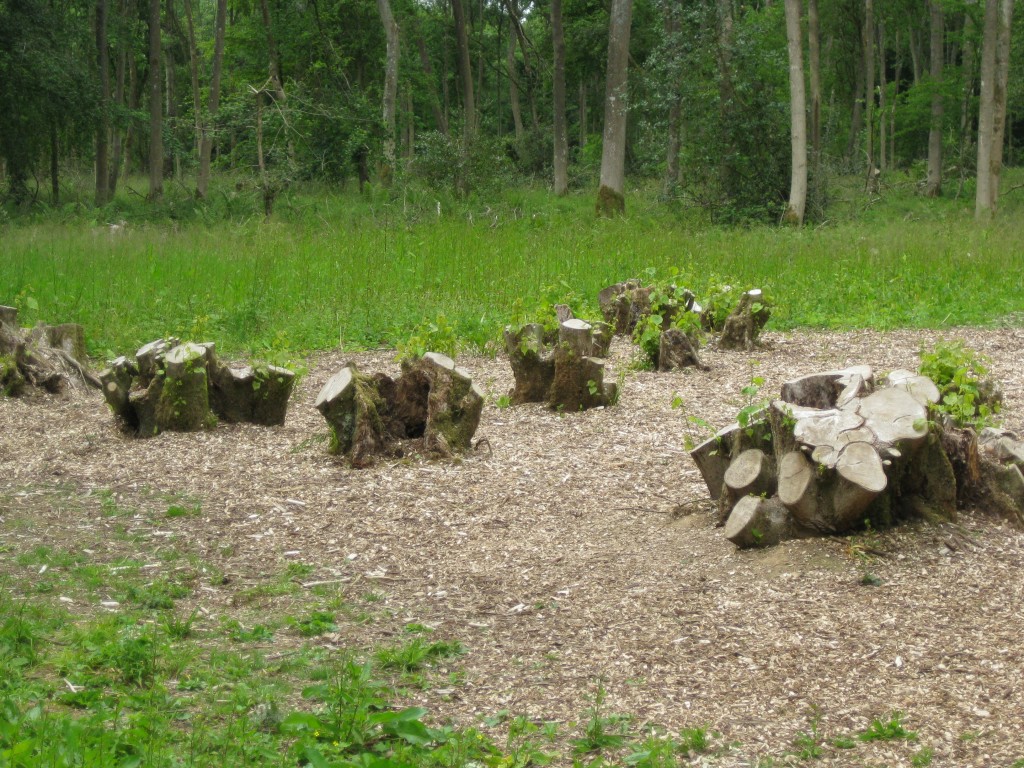 this linden (lime) tree has been coppiced since at least the 13th century! While British Columbia has been embarrassingly and heartbreakingly remiss in its protection of Vancouver Island’s ancient firs, there are pockets of silvicultural enlightenment elsewhere in the world that can restore one’s faith in humanity. Last month Ruth and I spent a memorable afternoon at the Westonbirt Arboretum and got introduced to some of its innovative programs by director Simon Toomer. It may sound odd, but one of the highlights of our tour was seeing the manifold stumps of a recently harvested lime (Tilia sp.) tree, which has been harvested using the coppicing technique since at least the 13th century. The tree itself, which has spread out into about 60 individual stems, could be over a thousand years old! Coppicing (periodic cutting from regrowth regenerated from stumps or ‘stools’) is an ancient technique, suitable for a variety of mostly broadleaf trees, which paradoxically causes them to live much longer than if they were allowed to grow uncut. The practice periodically opens up parts of the forest canopy, allowing for an influx of light and a host of species dependent on brighter conditons, which enhances diversity in the forest, without massacring the entire structure over a large landscape as is done during industrial clear cutting. In British Columbia, it would definitely be worth testing out large-scale coppice management of Big-leafed maple (Acer macrophyllum) and Red Alder (Alnus rubra), both of which are capable of rapid regeneration from stumps and which have the potential to produce a range of sustainable wood products.
Westonbirt is also engaged in pioneering research on how forests will be affected by climate change and have initiated a series of long term trials of trees, hailing from a spectrum of locations, from the southern to northern parts of their present day ranges. If conditions continue to heat up, it is likely that trees evolving in more southerly latitudes will increasingly thrive within the British landscape, while more cold-adapted ones will only do well at higher latitudes and altitudes.
Back in British Columbia, I am beginning to draw similar conclusions. Though still in its early stages, the initial results of my Cortes Island ‘Neo-Eocene’ project indicate that some tree species now native to more southerly latitudes, such as Coast Redwood (Sequoia sempervirens) and Metasequoia (Metasequoia glyptostroboides) might actually grow faster under West Coast Canadian conditions than varieties currently prescribed for re-forestation, such as Western Red cedar (Thuja plicata). The difference is likely to intensify as northern climates continue to heat up. Climate warming is already causing massive mortality in northern populations of the native yellow cypress/cedar (Cupressus nootkatensis), because spring snow cover is no longer thick enough to protect their delicate roots from late frosts.
The premise of ‘Neo-Eocene’ is that we need to examine longer, more geologic time spans for guidance on how ecosystems might deal with the rapidly unfolding effects of anthropogenic climate change. During the Eocene Thermal Maximum, some 55 million years ago, taxa such as Sequoia, Metasequoia and Gingko, which are now extremely limited in natural distribution, did in fact range far into northern latitudes; so it makes sense to experimentally reintroduce them, especially to areas where the extant forest has been compromised by industrial logging or climate-change induced die-offs. Our concept of what is considered ‘native’ needs to be rethought, and we’ll have to expand our definition to encompass organisms that have been ‘prehistorically native.’ So bring on the Giant Ground Sloths! If only we could!
Apropos of the topic of ‘Deep Time,’ I have been invited to Finland this September to participate in the Field_Notes – Deep Time residency in subarctic Kilpisjärvi Finland. Along with the Smudge Studio folks and a bunch of other amazing people, I’ll be considering how developing a more ‘geologic’ perspective might help assess our trajectory into the deep future. As the world heats up again to levels seen only in the geologic, pre-human past, how will we cope? How long will it take for a subarctic place like Kilpisjärvi to feel like Lisbon or Lagos? Will more southerly latitudes, once temperate and agriculturally productive, become thermally uninhabitable? Will climate refugees, human and non-human, flood into the formally frigid northland? How might the northern biota adapt? Or can it? Anyway, I am endlessly excited.
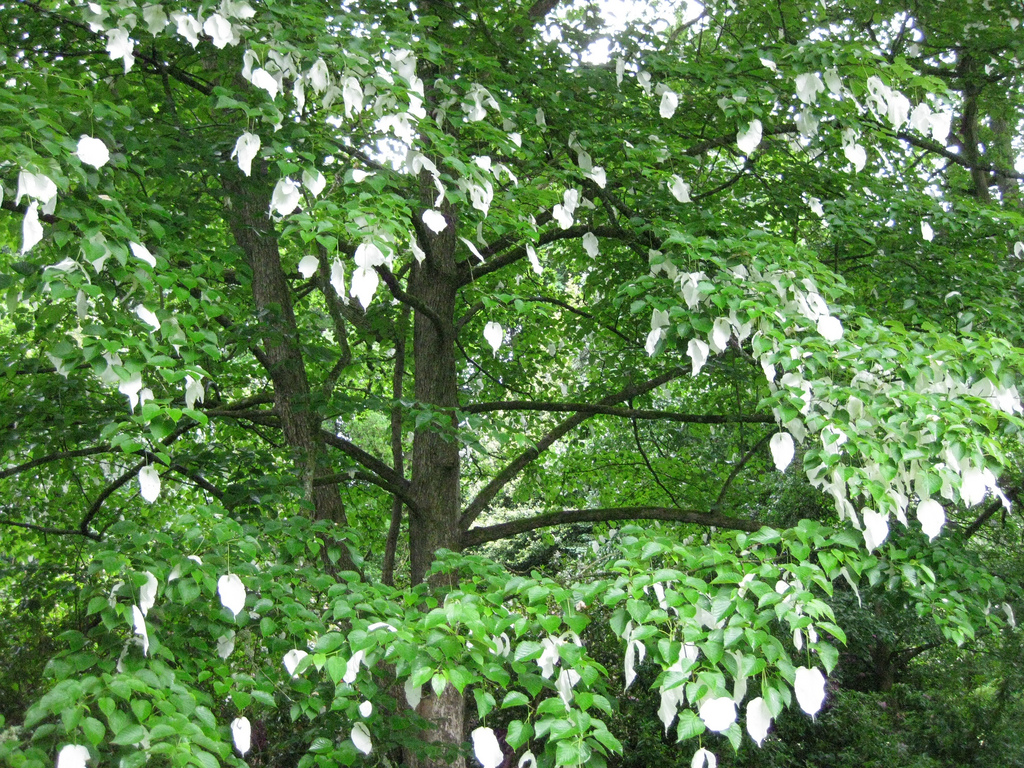 Davidia tree in Wiltshire Another refugee from deep time is the wonderfully flamboyant Davidia tree, which dates back all the way to the Miocene, when it was much more widely distributed. Miraculously, a few groves somehow survived the intervening millennia deep within the gorges of Szechuan China. The tree with its magnificent, floppy white bracts, which some liken to handkerchiefs or doves, caught the attention of a French missionary, Abbé Armand David. He sent some dried samples back to Europe and a botanical sensation promptly ensued. It wasn’t long before a plant hunters from England and the United States were dispatched to what was then a very remote area, charged with collecting Davidia seeds for cultivation. In the Davidia’s case, this proved to be a boon for the global population as there are now fine specimens of the tree flourishing in parks and gardens throughout the temperate zones of the world, thanks to those early batches of seed. Davidia, as is the case with Metasequoia and Gingko are considered vulnerable in their native habitat, and it is only through their widespread cultivation outside the small territories in which they still naturally occur that their future remains assured. Yet who knows? These curious and obscure trees might contain within them a genetic willingness to reestablish themselves in vast swathes of the northern hemisphere, as the climate of the distant geologic past becomes the climate of the not so distant future. Here is a picture of the biggest Davidia I have ever seen. It was in full, glorious bloom, when I visited the the grounds of a lovely Wiltshire property, owned by the Guinness family. Judging by its size, this specimen seems likely to have been one of the first ones propagated – an ambassador of sorts from the distant geologic past that once again has a role to play in the beauty of the wider world.
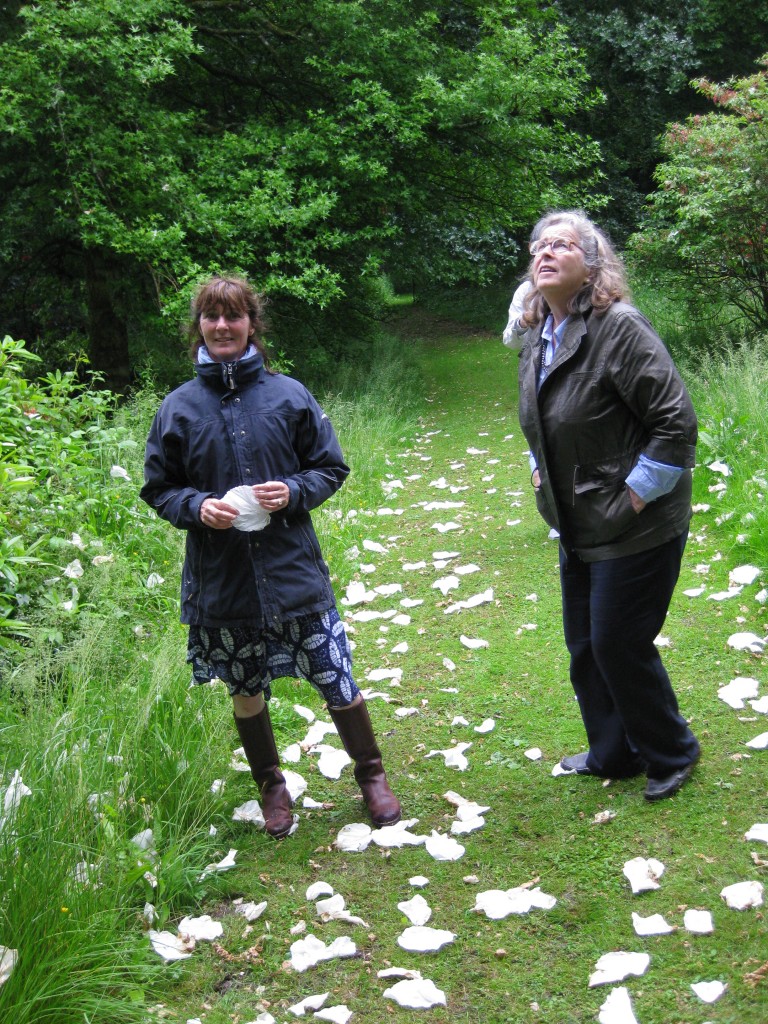 a flurry of doves or handkerchiefs!
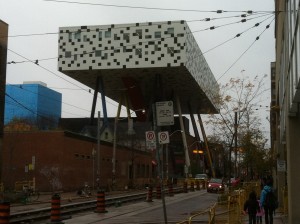 OCA now pimped out with polka dot office thingy
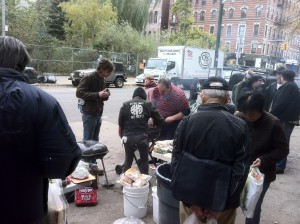 punks feeding the hungry at 9th and C
Though I was headed back to New York, Hurricane Sandy had other ideas and I got stuck in my hometown of Toronto for a few days, waiting for NYC’s airports to reopen. I have to say it was refreshing to hear a Jamaican guy outside the Lansdowne subway station cursing at random passersby, calling them ‘bloodclots’ as they rushed for the bus. Life on the West Coast is just so insufferably white bread and I miss these idiomatic Caribbean speech patterns, not to mention the great goat and okra rotis I tucked into at Vena’s – the local hole-in-the-wall Trinidadian place. Don’t even get me started about the West Coast’s lack of subways….
I had come to Ontario in the first place to attend a thirty-two year reunion of my long dead punk band ‘The Enemas’ (wince, wince) which happened in the smallish rust belt city of London. Though my own memories of 1979-81 were a bit on the sketchy side, my former band mates managed to play through our set with astonishing verve. Though I am less than sure of my musical talent these days, it was heartening to share memories of those early punk days with former demimondaines and be introduced to a whole new generation of aficionados who weren’t even born when we last played. More than anything, it is the punk rock aesthetic that has stuck with me all of these years – a sense of anti-authoritarian glee and the joy of improvisation; of not doing things by the book. For that sense of empowerment, I am eternally grateful.
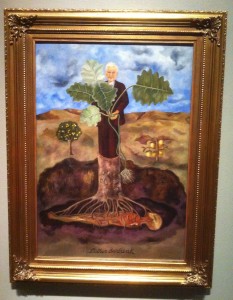 Frida Kahlo’s portrait of Luther Burbank Back in Toronto after the London event, my hurricane-induced hiatus allowed me to reacquaint myself with old Hog town, the city that essentially molded me as a young artist and writer. As well as viewing a lovely exhibition at the AGO, (curated by my old friend Dot Tuer) of works by Frida Kahlo and Diego Rivera, I swanned about some of the neighbourhoods I used to frequent and I couldn’t help noticing, (as I sometimes do after absences from once familiar places) that the remnants of my physical past – the buildings, the faces I once knew – have receded strangely into an aggregated matrix of history, obscuring what was once there – what is still in my mind – like a translucent veil or an alternate quantum state that oscillates in and out of the present like the cronosthesia suffered by Chris Marker’s protagonist in La Jetée. One of the few consolations to getting older I find, is that this ability, in one’s mind’s eye, to zoom in and out through one’s own history becomes astonishingly acute. The present more and more resembles the skin of some translucent, temporal onion, containing the nested layers of the past still glistening inside it, each existing as it once was, but within the corpus of a unified whole.
And that goes for the future too because as Baudrillard pointed out, the unimaginable has always been imagined to some extent. Which brings me to New York. Finally! After days of hurricane Sandy induced flight cancellations, the flooding had receded from the airport runways enough that I was able to board a plane for the short flight. Upon arrival at La Guardia, at first everything seemed more or less normal, but as the taxi crossed the Williamsburg bridge into the Loisaida it was as if I had entered a parallel, crepuscular universe. Though it was already early evening, there was no electric light to be seen anywhere and it felt as if I had traveled backward in time to some earlier, pre-electrical Manhattan. Traffic signals and street lights were all out and the windows of the storefronts and apartment buildings stared darkly into the shadowy streets. Knots of people sauntered along the sidewalks, at much slower than the usual frenetic Manhattan pace, and here and there as a diminished reminder of the historical present, a tiny cell phone screen glowed from the darkness, borne by unseen hands in search of what had become almost a memory of formerly ubiquitous reception.
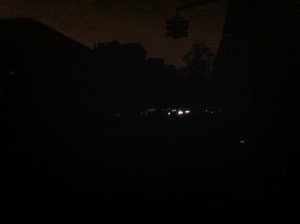 Alphabet City in the blackout
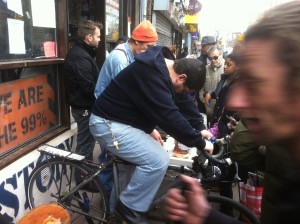 punk phone charging setup at 9th and C
As night fell further, I could see the darkness would absolute, save for vehicle headlights, a few wavering flashlights and the twinkle of candles in the windows of the occasional bar that stayed open, catering to the many in the neighbourhood who suddenly didn’t have much to do, except shiver in their cold, dark apartments. Being the nexus of entrepreneurialism that New York is, there were itinerant ice men driving around (where do they come from so suddenly?) hawking their now highly coveted wares to whomever would agree to their exorbitant prices.
“Ice – Ten dollars a bag!”
But cold beer is a welcome distraction from any disaster and I soon found myself atop a bar stool, enjoying a Pabst Blue Ribbon around the glow of a tiny tea candle in the otherwise Stygian darkness of Avenue B at 7th Street, joined by a friend from our building and a professional pet sitter named Nanette who drank her gin and tonic with a snuffling pug named Olive, perched on her lap like a furry, drooling accordion.
The next morning, the power was still out but I could see that the urban immune system had kicked in. While the ConEd trucks and National Guard vehicles went about their business, the punks at 9th and C have had barbecues going in front of their building and were attending to the many hungry people in the neighbourhood who had been having to make do without light, heat and in many cases water for these three days. The corner was one of the only localities in the neighbourhood in which get a cell-phone signal so it was full of people milling around with their handsets pressed to their ears or frantically texting. To my delight, the punks had provided a pedal-powered cell phone charger next to their outdoor kitchen, helping us all to maintain our tenuous links to the outside world.
Go Punks!
I’m so glad to report that at 9th and C at least, the punk spirit is alive and well and maybe it’s stronger now than ever. As climate change continues to heave and buckle the aging infrastructure of American capitalism, it is these anti-authoritarian ragamuffins who will increasingly be called upon to step up and save us. Welcome to the future. I think I like it!
Update: Though the power came on Friday night for many buildings here in Alphabet City, things are still very much sucking for the folks in the nearby PJs, many of whom live along the East River where the worst flooding happened. Along with the lack of light and heat, these unfortunates had to endure the exceptional torment of not having running water. To me, this was yet another object lesson on how, within the context of climate change and the general lack of readiness of North America’s tax-starved, aging infrastructure, it will be the poor who will disproportionately bear the brunt of what is coming. Tuesday’s coming election here can be seen as a referendum on how America views its social contract. Will the state make some committment to its historical responsibility to look after those less fortunate, or will be headed for a more brutal, individualist future? No matter what the outcome, I think we’ll be needing the spirited, do-it-yourself public service of those punk kids more and more.
|
|



















